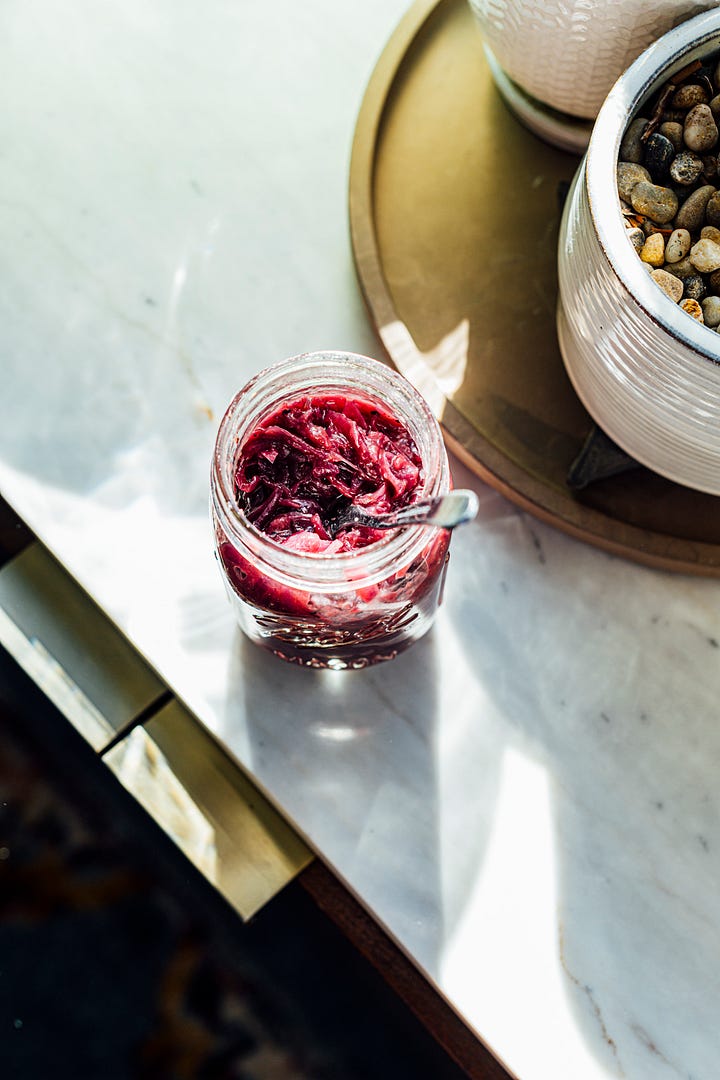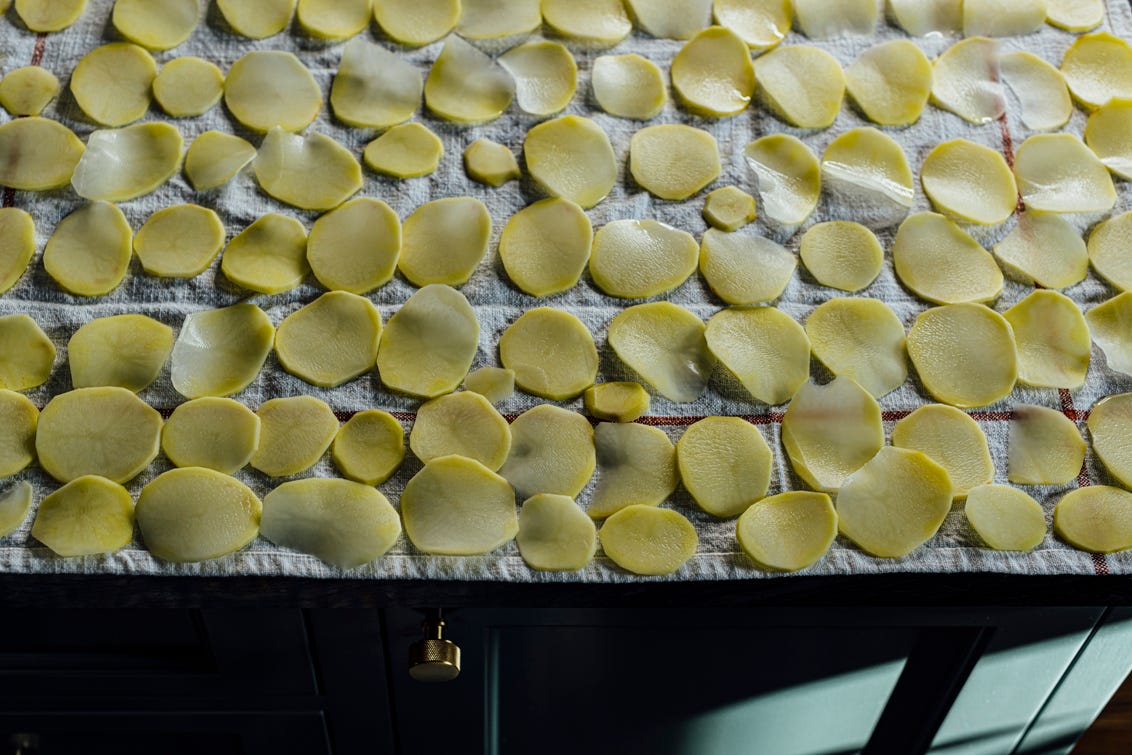Hello Friends,
One housekeeping item before I jump into this week’s recipe. We’ll do a live chat on Saturday, the 19th of November, at noon PST here on Substack. It’s a new feature that I’m thrilled about and provides another direct way for me to talk with you. Our topic will focus on Thanksgiving dinner and how to plan and prepare them in a fun and stress-free way. The chat will be open to all newsletter subscribers. Say hi, and bring your questions, it’s my first time, and I’m very excited to meet all of you. Besides being a subscriber, you will also need to download the Substack app to use the chat feature.
Like most people, I love potatoes in any shape and form. They’re on the menu for special occasions and celebrations but can also appear on an everyday meal. A pommes anna or potato galette (some might find a galette incorrect since there is no pastry) is a special treat, and I think every potato lover in the world would appreciate it. Visually it’s a stunner, a rosette of thinly sliced potatoes revealing their crispy golden-brown edges. One of those dishes steals the show at the dinner table. This year for Thanksgiving and the Holidays, I’m making this gorgeous pommes anna on repeat and encourage you to do so. It’s simple and makes everyone gasp in awe when they see it on the dinner table.
A pommes anna is easy to prepare, but you must keep a few things in mind. Focus on water, starch, and fat, and treat it like a bundt cake. Bear with me; you’ll see why in a little bit.
The first couple of times I made the pommes anna were absolute duds. The potatoes stuck to the pan, no matter how much fat I used. In some trials, the potatoes were charred instead of turning crisp. The lack of color in pommes anna bothered me; they looked insipid like a blood-starved vampire (I’m watching the new Anne Rice show, Interview with the Vampire) and lacked flavor. The latter was easier to fix, but the other problems took a bit of tweaking and problem-solving. Let’s address these, and by the end of this discourse, you’ll realize that this recipe is an exercise in working with metal ions and food.
The Potatoes
Starch potatoes like russets are the best option for this recipe. Peel and cut them thin to achieve a tighter coil of potatoes that covers the entire surface of the skillet and a nice crispy surface.
The Choice of Fat
Duck fat, schmaltz, bacon fat, and ghee produced the best results in my hands and the best flavor. The potatoes stuck more in olive oil than in the other fats. When I used butter, the milk solids separated from the butter burned and left a bitter burnt layer. Because butter also contains water, the water caused the potatoes to stick to the pan.
The Skillet
To make a pommes anna, you should use a cast-iron skillet or circular pan. A cake pan will also work. In terms of material, the best choice is cast iron. Do not use a non-stick pan.
The Temperature
The potatoes are subjected to heat twice. First, directly on the stove to help start the crisping process and, second, in the oven at 425F/220C to allow the potatoes to cook thoroughly.
A Heavy Weight
In a pommes anna, we want the potatoes to release quickly from the skillet, but we also want the potato slices to stick to each other, or else the rosette will fall apart. A heavy weight must be applied on top of the skillet as the potatoes cook in the oven. The easiest way to do this is to top the potatoes with a sheet of foil. Then place a cake pan or pie pan filled with ceramic pie beads or dried beans or rice (that you use for blind baking a pie crust) over the foil and press it gently down. The pressure from the weight will force the potato slices to cook together and stick to each other.
The Dual Problem of Starch and Water
A potato is a large bag containing many smaller bags of starch (granules) and water. When you slice a potato and rub it against your fingers or even look at the surface of the knife or the cutting board, a layer of white starch granules and water. The presence of starch and water on the surface of the potato slices causes many problems. It burns and makes the potato slices stick to the skillet's surface, and the potatoes don’t stick to each other properly. It’s a hot mess, literally!
To understand how to fix this, it’s essential to understand how cast iron skillets work. Cast iron skillets are made of iron, and iron can bind proteins as well as starch. When we add a layer of cooking fat, it coats the surface of the cast iron skillet and prevents the proteins and starch in food from sticking to the iron. When the potatoes are sliced, they release their starch along with water, causing problems for the pommes anna. The starch ends up sticking to the skillet even though there is a layer of fat. Before the potato slices are layered onto the surface of the pan, there are tossed with the cooking fat and spices. The problem with wet potato slices is that they won’t get coated well; everything slides off. To avoid all these problems, I did two things.
Soak the cut slices of potatoes in a cold-water bath of lemon juice. The citric acid in the lemon juice prevents the slices from browning (citric acid inhibits the food browning enzymes in plants called polyphenol oxidases). Shake the potato slices in that water to eliminate any excess starch released during slicing.
Layer the rinsed potato slices on a lint-free kitchen towel and let them air dry. This gets rid of any water on the surface. This might be the most tedious step in the recipe.
Add cornstarch. I know it sounds counterintuitive to throw in more starch because I just told you to wash all the starch off the potato slices. Bundt cake pans are coated with a mixture of fat and flour (a source of starch) or sugar. We don’t need to use sugar here because that would be bad. I borrowed the same idea and applied it here. First, brush the empty skillet with duck fat, sprinkle a little cornstarch over it, and then brush the mixture. You don’t need to heat the skillet for this but make sure the fat you apply is warm enough to spread all over the surface. Toss the air-dried potato slices with cornstarch, warm duck fat, garlic, and spices. As the potatoes cook, the water trapped inside them escapes and meets the cornstarch, acting like glue holding the potatoes together. It also creates a better crispier crust on the potatoes (it’s the same idea behind batter-fried foods like fried chicken and pakoras). But why does this make the potatoes slide off the skillet more easily? The cornstarch acts as an extra protection layer between the skillet and the potatoes. Most of the cornstarch that we added to the cooking fat binds the skillet and blocks the iron ions on the skillet's surface from binding the starch and proteins on the potatoes, and the potatoes slide off easily.
Flavor
Earlier, I mentioned how I found the color lacking on most pommes anna. It’s an easy fix, add a tiny amount of ground turmeric, and the rosette will look beautiful and actually golden all over not just on the edges. I added grated garlic to the hot duck fat, but you can also try other spices.
A Few Tips on Releasing the Pommes Anna
Remove the layer of foil as soon as the skillet comes out of the oven or else it might stick to the potatoes. I roll it off gently giving it a little nudge as I move the foil along the surface.
I know it is very tempting to eat potatoes straight out of a hot skillet especially when they’re this crispy. Let the potatoes in the skillet cool. Hot starchy foods need time to rest. If it is too hot, the starch will be a little mobile and so will the potatoes. The starch molecules that formed bonds between the potato slices need a little time to cool in order to stabilize.
Use a fish or an offset spatula to help release the pan. If you do end up having a corner that’s stuck, nudge the edge of the spatula to release it.
Be careful when you flip the skillet and the plate, hold them tight with a kitchen towel. It might as well be the end of the world if that beautiful rosette lands on the floor or you drop the skillet on your foot.
Serve the pommes anna with a tangy side. I love sour cream and this guava onion jam. I think you will love it too.
MORE RECIPES TO COOK
The Guava Onion Jam that I serve this pommes anna with is sweet and tangy and also makes a good gift for the holidays.
My Cacio E Pepe recipe strays from the traditional but I’ve made it easier and added some tricks to preparing this classic.










I was informed that the recipe link was broken for some, it's been fixed. Here's the link just in case https://abrowntable.com/home/pommes-anna